Salvia officinalis
Salvia officinalis (sage, also called garden sage, common sage, or culinary sage) is a perennial, evergreen subshrub, with woody stems, grayish leaves, and blue to purplish flowers. It is a member of the mint family Lamiaceae and native to the Mediterranean region, though it has been naturalized in many places throughout the world. It has a long history of medicinal and culinary use, and in modern times it has been used as an ornamental garden plant. The common name "sage" is also used for a number of related and unrelated species.
| Salvia officinalis | |
|---|---|
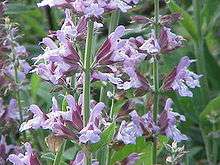 | |
| Flowers of Salvia officinalis | |
| Scientific classification | |
| Kingdom: | Plantae |
| Clade: | Tracheophytes |
| Clade: | Angiosperms |
| Clade: | Eudicots |
| Clade: | Asterids |
| Order: | Lamiales |
| Family: | Lamiaceae |
| Genus: | Salvia |
| Species: | S. officinalis |
| Binomial name | |
| Salvia officinalis | |
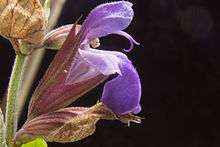
Names
Salvia officinalis has numerous common names. Some of the best-known are sage, common sage, garden sage, golden sage, kitchen sage, true sage, culinary sage, Dalmatian sage, and broadleaf sage. Cultivated forms include purple sage and red sage. The specific epithet officinalis refers to plants with a well-established medicinal or culinary value.[1]
Taxonomy
Salvia officinalis was described by Carl Linnaeus in 1753. It has been grown for centuries in the Old World for its food and healing properties, and was often described in old herbals for the many miraculous properties attributed to it.[2] The specific epithet, officinalis, refers to the plant's medicinal use—the officina was the traditional storeroom of a monastery where herbs and medicines were stored.[1][3] S. officinalis has been classified under many other scientific names over the years, including six different names since 1940 alone.[4] It is the type species for the genus Salvia.
The second most commonly used species of sage is Salvia lavandulaefolia, which shares a similar composition with Salvia officinalis, with the exception that lavandulaefolia contains very little of the potentially toxic GABAA receptor-antagonizing monoterpenoid thujone.[5]
Description
.jpg)
Cultivars are quite variable in size, leaf and flower color, and foliage pattern, with many variegated leaf types. The Old World type grows to approximately 2 ft (0.61 m) tall and wide, with lavender flowers most common, though they can also be white, pink, or purple. The plant flowers in late spring or summer. The leaves are oblong, ranging in size up to 2.5 in (6.4 cm) long by 1 in (2.5 cm) wide. Leaves are grey-green, rugose on the upper side, and nearly white underneath due to the many short soft hairs. Modern cultivars include leaves with purple, rose, cream, and yellow in many variegated combinations.[2]
History
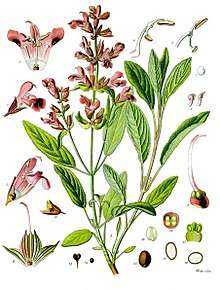
Salvia officinalis has been used since ancient times for warding off evil, snakebites, increasing women's fertility, and more. The Romans referred to sage as the "holy herb," and employed it in their religious rituals.[6] Theophrastus wrote about two different sages, a wild undershrub he called sphakos, and a similar cultivated plant he called elelisphakos. Pliny the Elder said the latter plant was called salvia by the Romans, and used as a diuretic, a local anesthetic for the skin, a styptic, and for other uses. Charlemagne recommended the plant for cultivation in the early Middle Ages, and during the Carolingian Empire, it was cultivated in monastery gardens.[7] Walafrid Strabo described it in his poem Hortulus as having a sweet scent and being useful for many human ailments—he went back to the Greek root for the name and called it lelifagus.[8]
The plant had a high reputation throughout the Middle Ages, with many sayings referring to its healing properties and value.[9] It was sometimes called S. salvatrix (sage the savior). Dioscorides, Pliny, and Galen all recommended sage as a diuretic, hemostatic, emmenagogue, and tonic.[8] Le Menagier de Paris, in addition to recommending cold sage soup and sage sauce for poultry, recommends infusion of sage for washing hands at table.[10] John Gerard's Herball (1597) states that sage "is singularly good for the head and brain, it quickeneth the senses and memory, strengtheneth the sinews, restoreth health to those that have the palsy, and taketh away shakey trembling of the members."[11] Gervase Markham's The English Huswife (1615) gives a recipe for a tooth-powder of sage and salt.[12] It appears in recipes for Four Thieves Vinegar, a blend of herbs which was supposed to ward off the plague. In past centuries, it was also used for hair care, insect bites and wasp stings, nervous conditions, mental conditions, oral preparations for inflammation of the mouth, tongue and throat, and also to reduce fevers.[8]
Uses
Culinary use
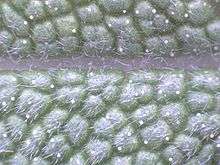
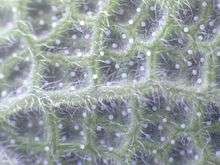
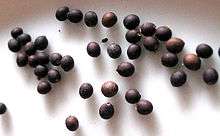
In Britain, sage has for generations been listed as one of the essential herbs, along with parsley, rosemary, and thyme (as in the folk song "Scarborough Fair"). It has a savory, slightly peppery flavor. Sage appears in the 14th and 15th centuries in a "Cold Sage Sauce", known in French, English and Lombard cuisine, probably traceable to its appearance in Le Viandier de Taillevent.[13] It appears in many European cuisines, notably Italian, Balkan and Middle Eastern cookery. In Italian cuisine, it is an essential condiment for saltimbocca and other dishes, favored with fish. In British and American cooking, it is traditionally served as sage and onion stuffing, an accompaniment to roast turkey or chicken at Christmas or Thanksgiving Day, and for Sunday roast dinners. Other dishes include pork casserole, Sage Derby cheese and Lincolnshire sausages. Despite the common use of traditional and available herbs in French cuisine, sage never found favor there.
In the Levant and Egypt it is commonly used as a flavor for hot black tea, or boiled and served as an herbal drink in its own right.
Essential oil
Common sage is grown in parts of Europe for distillation of an essential oil, although other species such as Salvia fruticosa may also be harvested and distilled with it. The essential oil contains cineole, borneol, and thujone. Sage leaf contains tannic acid, oleic acid, ursolic acid, carnosol, carnosic acid, fumaric acid, chlorogenic acid, caffeic acid, niacin, nicotinamide, flavones, flavonoid glycosides, and estrogenic substances.[14]
Medical research
Some research has suggested certain extracts of salvia officinalis may have positive effects on human brain function, but due to significant methodological problems, no firm conclusions can be drawn.[15][16] The thujone present in Salvia extracts may be neurotoxic.[16]
Cultivars
In favorable conditions in the garden, S. officinalis can grow to a substantial size (1 square metre or more), but a number of cultivars are more compact. As such they are valued as small ornamental flowering shrubs, rather than for their herbal properties. Some provide low ground cover, especially in sunny dry environments. Like many herbs they can be killed by a cold wet winter, especially if the soil is not well drained. But they are easily propagated from summer cuttings, and some cultivars are produced from seeds.
Named cultivars include:
- 'Alba', a white-flowered cultivar
- 'Aurea', golden sage
- 'Berggarten', a cultivar with large leaves, which rarely blooms, extending the useful life of the leaves
- 'Extrakta', has leaves with higher oil concentrations
- 'Icterina', a cultivar with yellow-green variegated leaves
- 'Lavandulaefolia', a small leaved cultivar
- 'Purpurascens' ('Purpurea'), a purple-leafed cultivar
- 'Tricolor', a cultivar with white, purple and green variegated leaves
'Icterina'[17] and 'Purpurascens'[18] have gained the Royal Horticultural Society's Award of Garden Merit.[19]
- 'Berggarten'
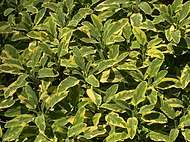 'Icterina'
'Icterina'- 'Purpurascens'
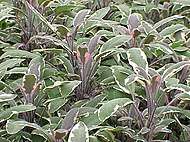 'Tricolor'
'Tricolor'
References
- Harrison, Lorraine (2012). RHS Latin for gardeners. United Kingdom: Mitchell Beazley. p. 224. ISBN 9781845337315.
- Clebsch, Betsy; Carol D. Barner (2003). The New Book of Salvias. Timber Press. p. 216. ISBN 978-0-88192-560-9.
- Stearn, William T. (2004). Botanical Latin. Timber Press (OR). p. 456. ISBN 978-0-88192-627-9.
- Sutton, John (2004). The Gardener's Guide to Growing Salvias. Workman Publishing Company. p. 17. ISBN 978-0-88192-671-2.
- Olsen, RW (25 April 2000). "Absinthe and gamma-aminobutyric acid receptors". Proceedings of the National Academy of Sciences of the United States of America. 97 (9): 4417–8. doi:10.1073/pnas.97.9.4417. PMC 34311. PMID 10781032.
- Greer, John Michael (2017). The Encyclopedia of Natural Magic (First ed.). Woodbury, MN: Llewellyn Publications. p. 185. ISBN 9780738706740.
- Watters, L. L. (1901). An Analytical Investigation of Garden Sage (Salvia officinalis, Linne). New York: Columbia University.
- Kintzios, Spiridon E. (2000). Sage: The Genus Salvia. CRC Press. pp. 10–11. ISBN 978-90-5823-005-8.
- An Anglo-Saxon manuscript read "Why should man die when he has sage?" Kintzios, p. 10
- "Le Menagier de Paris". Hinson, Janet, translator. 1393.CS1 maint: others (link)
- Grieve, Maud (1971). A Modern Herbal: The Medicinal, Culinary, Cosmetic and Economic Properties, Cultivation and Folk-lore of Herbs, Grasses, Fungi, Shrubs, & Trees with All Their Modern Scientific Uses, Volume 2.
- Markham, Gervase (1615). The English House-wife.
- Le Viandier de Taillevent: 14th Century Cookery, Based on the Vatican Library Manuscript. Translated by Prescott, James. Eugene, Oregon: Alfarhaugr Publishing Society. 1989. p. 27. ISBN 978-0-9623719-0-5.
- "Sage". OBeWise Nutriceutica. Applied Health. Archived from the original on November 26, 2007. Retrieved 2008-02-04.
- Miroddi M, Navarra M, Quattropani MC, Calapai F, Gangemi S, Calapai G (2014). "Systematic review of clinical trials assessing pharmacological properties of Salvia species on memory, cognitive impairment and Alzheimer's disease". CNS Neurosci Ther. 20 (6): 485–95. doi:10.1111/cns.12270. PMC 6493168. PMID 24836739.
- Lopresti AL (2017). "Salvia (Sage): A Review of its Potential Cognitive-Enhancing and Protective Effects". Drugs in R&D. 17 (1): 53–64. doi:10.1007/s40268-016-0157-5. PMC 5318325. PMID 27888449.
- "RHS Plant Selector - Salvia officinalis 'Icterina'". Retrieved 26 July 2013.
- "RHS Plant Selector - Salvia officinalis 'Purpurascens'". Retrieved 2 June 2013.
- "AGM Plants - Ornamental" (PDF). Royal Horticultural Society. July 2017. p. 94. Retrieved 12 October 2018.
External links
| Wikimedia Commons has media related to Salvia officinalis. |
- American Botanical Council
- Historical medicinal use: from botanical.com
- Salvia officinalis Israel Native Plants
- Ghorbani, Ahmad; Esmaeilizadeh, Mahdi (October 2017). "Pharmacological properties of Salvia officinalis and its components". Journal of Traditional and Complementary Medicine. 7 (4): 433–440. doi:10.1016/j.jtcme.2016.12.014. PMC 5634728. PMID 29034191.